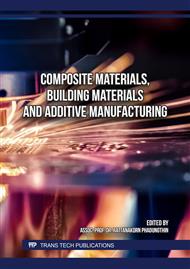p.29
p.41
p.49
p.61
p.67
p.75
p.85
p.99
p.109
Examination of Microstructure, Mechanical Properties, and Fatigue Strength in a Wire Arc Additively Manufactured Material Comprising Dissimilar Materials: AISI 316L Stainless Steel and Carbon Steel
Abstract:
This study provides a comprehensive investigation into the microstructure, hardness, tensile strength, and bending fatigue behavior of a Wire Arc Additively Manufactured (WAAM) component composed of dissimilar materials—Carbon Steel (CS) and 316L stainless steel. Microscopic analysis reveals distinct microstructural characteristics, such as equiaxed ferrite grains in WAAM CS and a coarse columnar structure with delta-ferrite phases in WAAM 316L. A macroscopic phase map indicates a predominantly Body-Centered Cubic (BCC) structure near the interphase, suggesting element migration between CS and 316L due to high heat input. Higher magnification scans highlight martensitic structures on both sides of the interphase, with the CS side exhibiting larger grain sizes. Hardness assessment along the built direction shows a peak hardness of 407 HV near the interphase on the 316L side, contrasting with the CS side's average interphase hardness of 316 HV due to larger grain sizes. The yield strength of both WAAM CS and WAAM dissimilar material was consistently measured at 392 MPa. In comparison, WAAM 316L exhibited a slightly lower yield strength of 359 MPa. Notably, WAAM 316L demonstrated the highest tensile strength among the materials, reaching 656 MPa. Meanwhile, WAAM CS displayed a robust tensile strength of 503 MPa, and the WAAM dissimilar material exhibited a yield strength of 520 MPa. In terms of elongation, WAAM CS and WAAM 316L showcased values of 44.9% and 49.6%, respectively. On the other hand, WAAM dissimilar material exhibited a somewhat lower elongation of 20.4%, suggesting a different mechanical behavior in terms of ductility. Bending fatigue tests on WAAM 316L, WAAM CS, and the dissimilar material reveal a fatigue limit of approximately 225 MPa for WAAM 316L, 210 MPa for WAAM CS, and approximately 210 MPa for the dissimilar material. In the low-cycle and medium-cycle regimes, the dissimilar material exhibits slightly superior fatigue strength, potentially due to its marginally higher static strength. Notably, consistent fractures on the CS side during fatigue tests underscore a recurring behavior in the dissimilar material.
Info:
Periodical:
Pages:
75-82
Citation:
Online since:
November 2024
Authors:
Price:
Сopyright:
© 2024 Trans Tech Publications Ltd. All Rights Reserved
Share:
Citation:



